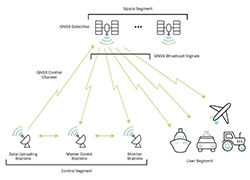In recent years, Russia has successfully taken its electronic warfare capabilities to a new level through the widespread use of global navigation satellite system (GNSS) technology. This capability is not only reflected in the military field, but also penetrates into the private field of Russian high-level officials, such as the luxury villa areas owned by senior government officials.
The Introduction of GNSS
A Global Navigation Satellite System (GNSS) is a network of satellites that broadcast timing and orbit information used for navigation and positioning measurements. GNSS is more than just satellites orbiting the Earth. Groups of satellites, called constellations, broadcast signals to master control stations and GNSS users around the world. All three components (space, control, and user) are considered part of GNSS.But most frequently, GNSS is used to describe the satellites in space.

GNSS operation process diagram
There are four main constellations in orbit – GPS, GLONASS, Galileo and BeiDou as well as two regional systems QZSS and IRNSS – and each are managed by a different country:
| Coverage | Operator | Satellites in Orbit | |
| GPS | Global | US Space Force | 31 |
| GLONASS | Global | Roscosmos | 24 |
| Galileo | Global | GSA and ESA | 26 |
| BeiDou | Global | CNSA | 48 |
| QZSS | Regional | JAXA | 4 |
| IRNSS/NavIC | Regional | ISRO | 8 |
GNSS signal jammers in Russian villa areas

According to an investigation by the Russian independent media group "The Project", reporters have repeatedly failed when trying to use drones to photograph these luxury villas from the air. These failures are likely due to GNSS jammer devices in the villas. GNSS signal jammers can block or disrupt drone navigation systems, making it impossible to accurately locate and perform tasks.
Widespread application in the military and security fields
The military and security departments of most countries have equipment to block GPS and other satellite navigation signals to prevent hostile forces from using these signals. However, Russia has gone a step further and developed GNSS jamming technology into a routinely displayed "art". The Russian military has long been proud of its electronic warfare capabilities and sees them as an important means of countering Western high-tech weapons. In 2015, Russian media "Sputnik" reported that the Russian military claimed that its electronic warfare capabilities "can make aircraft carriers useless."
The GPS system is the core technology of many Western weapon systems and critical infrastructure. Therefore, jamming and spoofing GPS and other GNSS systems has always been an important task for the Russian military. As early as 1997, Russian companies developed a four-watt GPS and GLONASS jammer that can effectively jam signals within a range of 150 to 200 kilometers. More advanced, these jammers are equipped with directional antennas that can focus interference on specific targets while not affecting other users. The potential of this technology has attracted the interest of the US military, and even spent nearly $200,000 in 2002 to purchase such equipment for testing and evaluation.
The international impact of GNSS satellite jamming
Russia's GNSS jamming activities are not limited to its homeland, and vehicles, ships and aircraft in other countries are also affected by it. A C4ADS report documents the near-constant operation of large Russian “smart jammers” in Syria, with impacts far beyond the country’s borders. Such smart jammers transmit seemingly valid GPS signals, but their content prevents receivers from accurately calculating their location. This jamming activity has not only affected international waters near Syria, but has also triggered multiple warnings from the U.S. Maritime Administration about satellite GPS jamming, as well as warnings from the European Air Traffic Control Authority about international airspace in the eastern Mediterranean.
The Baltic and Scandinavian countries have also experienced Russian GPS jamming in recent years. For example, in 2017, the NATO Secretary-General complained that Russian naval jamming activities had led to degraded mobile phone service in Latvia, Norway, and Sweden.
Russia’s Strategic Intentions
Through its frequent GNSS jamming and spoofing operations, Russia has demonstrated its strategic intent to use this technology as a homeland security tool and a means of power projection. The portability and widespread use of its equipment sends a clear signal to the West: Russia is ready to weaken or even seize key GNSS services and gain an advantage in electronic warfare.





